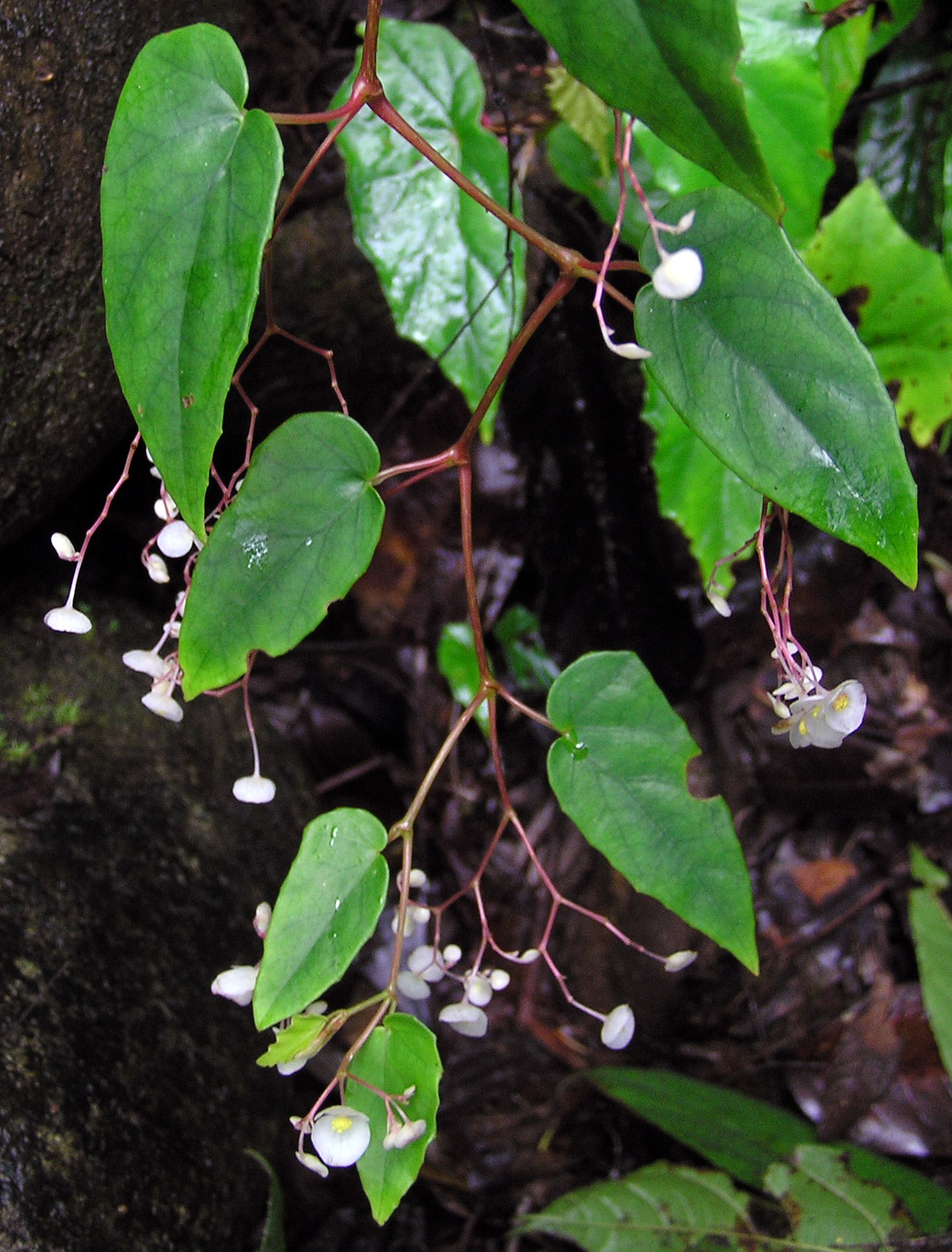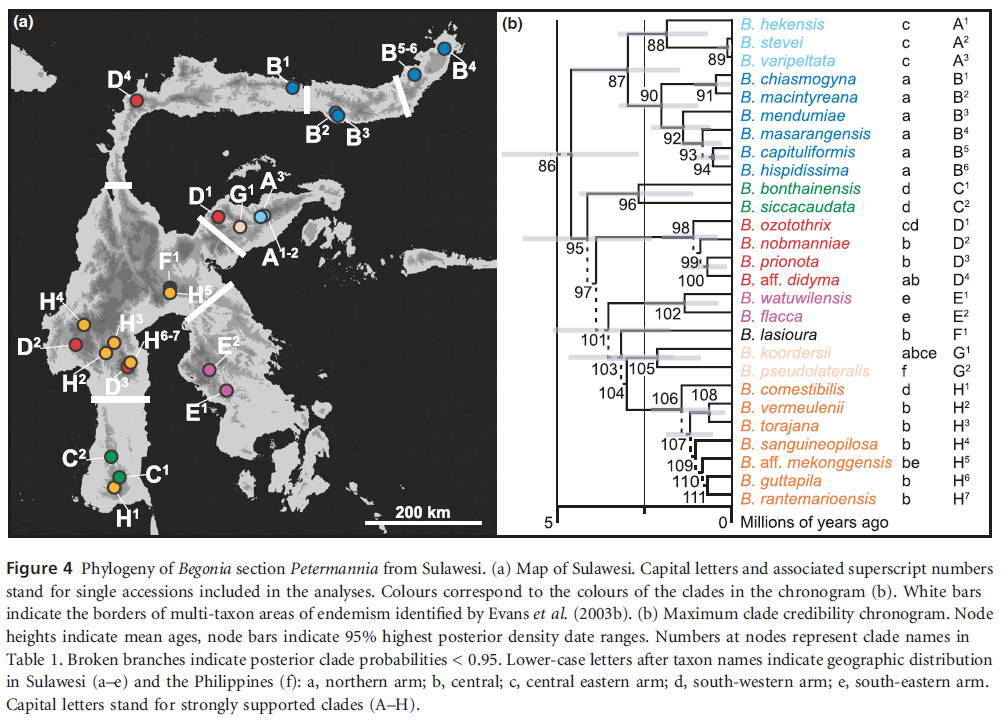Begonia varipeltata, nom. val., in Edinburgh J. Bot. 65(3): 370. 2006
Primary tabs

Diagnosis
- Begoniae macintyreanae M.Hughes similis a qua caulibus pendulis (non erectis) et foliis aliquantis peltatis (non omnibus basifixis) differt. - Type: Cultivated at the Royal Botanic Garden Edinburgh, from seed collected in the wild (Indonesia, Sulawesi, Tengah, Luwuk District, Bunta Subdistrict, Sumber Agung Village, Sungai SPA, 00°09.126S, 122°09.288E, 200 m), 24 ix 2007, D.C. Thomas 07-21 (holo E; iso L). (Thomas, D.C. & Hughes, M. 2008: Begonia varipeltata (Begoniaceae): A new peltate species from Sulawesi, Indonesia. – Edinburgh Journal of Botany 65(3): 369-374)
Description
- Perennial, monoecious herb.
Stems woody at base, to 12 mm across, erect for 30-70 cm in the basal part, but pendent in the more distal part, the pendent part up to 54 cm long, internodes 3-10.2 cm long, glabrous.
Leaves alternate, excentrically peltate or both excentrically peltate and basifixed leaves present; stipules 14-23 × 4-10 mm, oblong or narrowly elliptic, cymbiform with abaxially prominent midrib forming a thin, c.1-2 mm long appendage at the apex, caducous; petioles 1.2-4.2 cm long, glabrous; lamina very asymmetric, ovate, narrowly elliptic or oblong, 9.7-21.5 × 3.1-6.9 cm, margin irregularly serrate to dentate, glabrous, dark green above and pale green below, venation palmate-pinnate, base cordate (basifixed leaves) with not or only slightly overlapping lobes, apex acuminate.
Inflorescences bisexual or unisexual, protogynous, cymose, composed of (0-)1 basal, female (partial-) inflorescence with 2 female flowers and (0-)1-6 distal, male (partial-) inflorescence(s), each with 2-7 cymose branching points, dichasial or with dichasial branching in the basal part and monochasial branching in the distal part, with c.5-30 flowers.
Male flowers: pedicels 2-14 mm; tepals 2, broadly ovate to subcircular, 6-10 × 5-11 mm, base cuneate to truncate or tepal margin convex at base, apex rounded, white or pinkish, glabrous; androecium of c.25-30 stamens, yellow, symmetric, filaments slightly fused at the base, unequal, the longer in the middle, anthers obovate, slightly longer than to c.2 times shorter than the filaments, c.0.7-1.2 mm long, dehiscing through unilaterally positioned slits > ½ as long as the anther, connective not extended.
Female flowers: pedicels 9-26 mm; tepals 5, obovate, unequal, 9-16 mm long, the four outer 5-12 mm wide, the innermost 3-7 mm wide, white, glabrous; ovary 8-12 mm long, 3-locular, placentation axile, placentae bifid, ovary 3-winged, wings subequal, 12-14 mm long and 5-11 mm wide at the widest point (in the most distal part), apex truncate or with convex margins, base with convex margins or cuneate, glabrous; style fused only in the very basal part, 3-branched, each stylodium bifurcate in the stigmatic region, deciduous, stigmatic surface a twice spirally twisted papillose band, greenish-yellow or yellow.
Fruits pendulous, 3-winged, wing shape as for ovary, dehiscent, drying pale brown, glabrous. Seeds barrel-shaped, c.0.3 mm long, collar cells c.2/3 the length of the seed. (Thomas, D.C. & Hughes, M. 2008: Begonia varipeltata (Begoniaceae): A new peltate species from Sulawesi, Indonesia. – Edinburgh Journal of Botany 65(3): 369-374)
Habitat
- Growing on rock walls along the sides of river banks and in disturbed primary forest at low altitudes (c. 100-200 m asl.).
Conservation
- Proposed IUCN conservation category: VU D2. The likelihood that this species has a very restricted range in an area which shows clear signs of anthropogenic disturbance, especially timber harvesting, and which has no legal protection as a national park, wildlife or forest reserve, makes it "prone to the effects of human activities or stochastic events within a very short time period in an uncertain future" (IUCN, 2001). (Thomas, D.C. & Hughes, M. 2008: Begonia varipeltata (Begoniaceae): A new peltate species from Sulawesi, Indonesia. – Edinburgh Journal of Botany 65(3): 369-374)
Distribution
Asia-Tropical: Sulawesi (Sulawesi endemic)
Endemic to Indonesia, Sulawesi, Central Sulawesi.
See specimen tab for map of point distribution data of georeferenced specimens.
See specimen tab for map of point distribution data of georeferenced specimens.
Etymology
- The epithet varipeltata refers to the variable transition of petiole and lamina in this species, which ranges from basifixed, to strongly excentrically peltate to almost centrally peltate. (Thomas, D.C. & Hughes, M. 2008: Begonia varipeltata (Begoniaceae): A new peltate species from Sulawesi, Indonesia. – Edinburgh Journal of Botany 65(3): 369-374)A
Notes
- The epithet varipeltata refers to the variable transition of petiole and lamina in this species, which ranges from basifixed, to strongly excentrically peltate to almost centrally peltate. This great variation is similar to the condition described for Begonia amphioxus Sands (Sands, 1990). However, Begonia amphioxus clearly differs from B. varipeltata in both vegetative and generative morphology - for example, B. amphioxus has male flowers with four tepals, two-locular and usually two-winged ovaries, and distinctly narrower, spotted leaves (see Sands, 1990). Peltate species are rare in Begonia section Petermannia, and only two other species of Sulawesi Begonia with peltate species have been described (see Begonia comestibilis D.C.Thomas & Ardi and Begonia vermeulenii D.C.Thomas).
Molecular Systematics
- GenBank ()
- see Thomas et al., 2011 (Thomas, D.C., Hughes, M., Phutthai, T., Rajbhandary, S., Rubite, R., Ardi, W.H. & Richardson, J.E. 2011: A non-coding plastid DNA phylogeny of Asian Begonia(Begoniaceae): Evidence for morphological homoplasy and sectional polyphyly. – Molecular Phylogenetics and Evolution 60: 428-444)
- see Thomas et al., 2012 (Thomas, D.C., Hughes, M., Phutthai, T., Ardi, W.H., Rajbhandary, S., Rubite, R., Twyford, A.D. & Richardson, J.E. 2012: West to east dispersal and subsequent rapid diversification of the mega-diverse genus Begonia (Begoniaceae) in the Malesian archipelago. – Journal of Biogeography 39: 98-113)
 |


